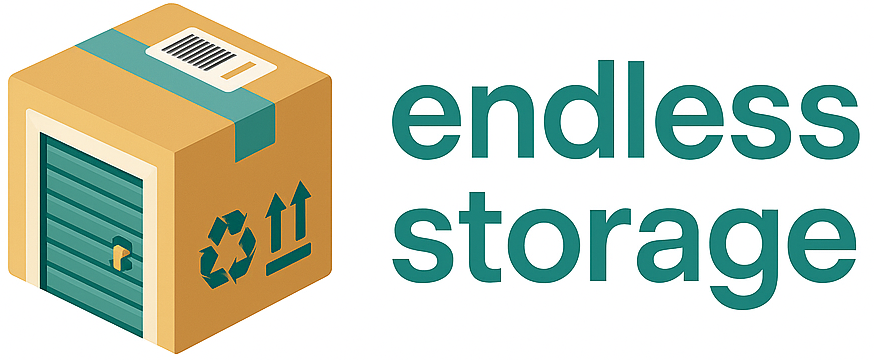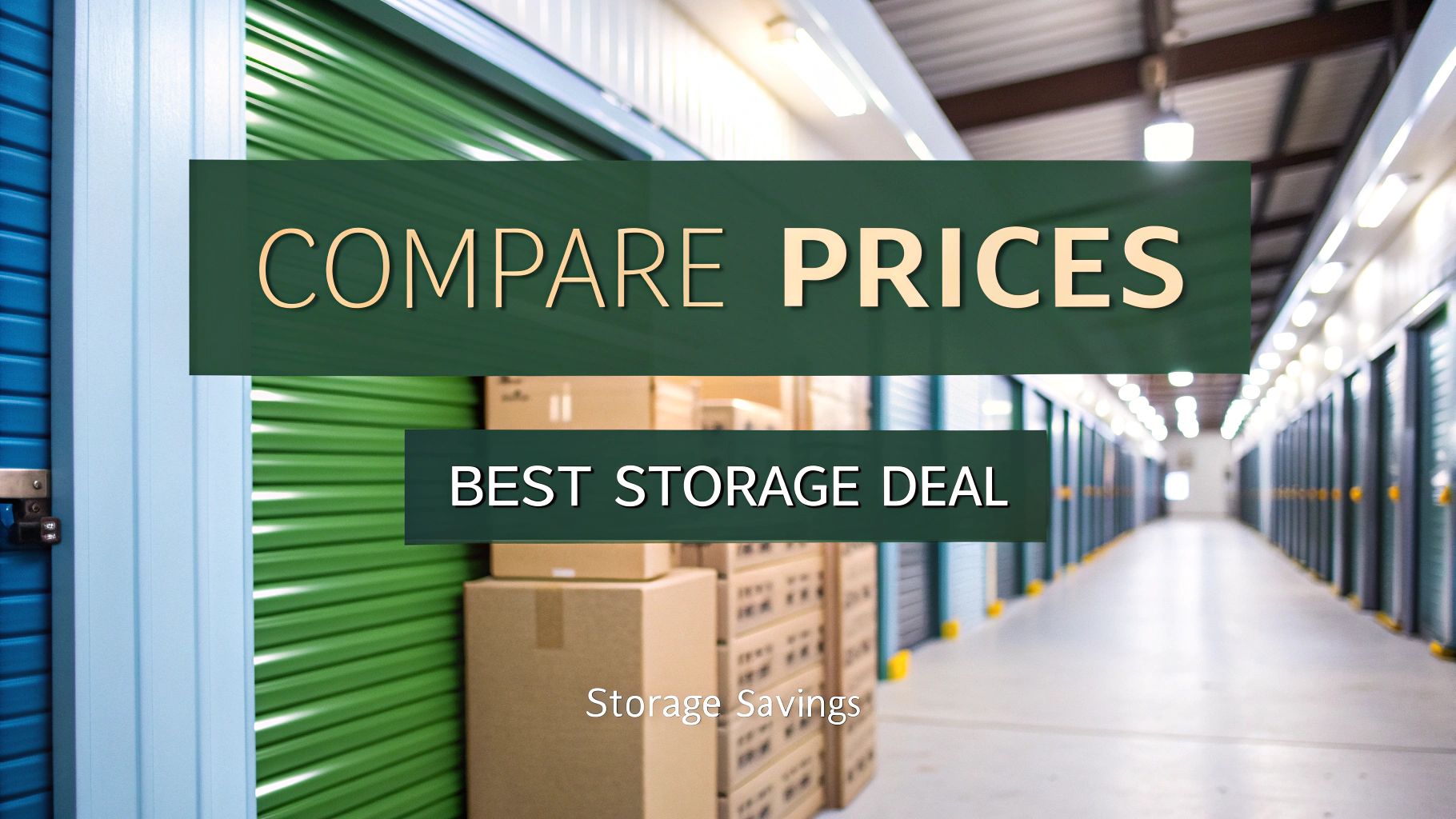When you start comparing storage unit prices, it’s easy to get fixated on the monthly rate. But that sticker price? It’s just the starting point. The real cost gets shaped by a few key factors like unit size, where it’s located, and any special features you might need. Getting a handle on these variables is the only way to find a genuinely good deal.
Understanding What Drives Storage Unit Prices
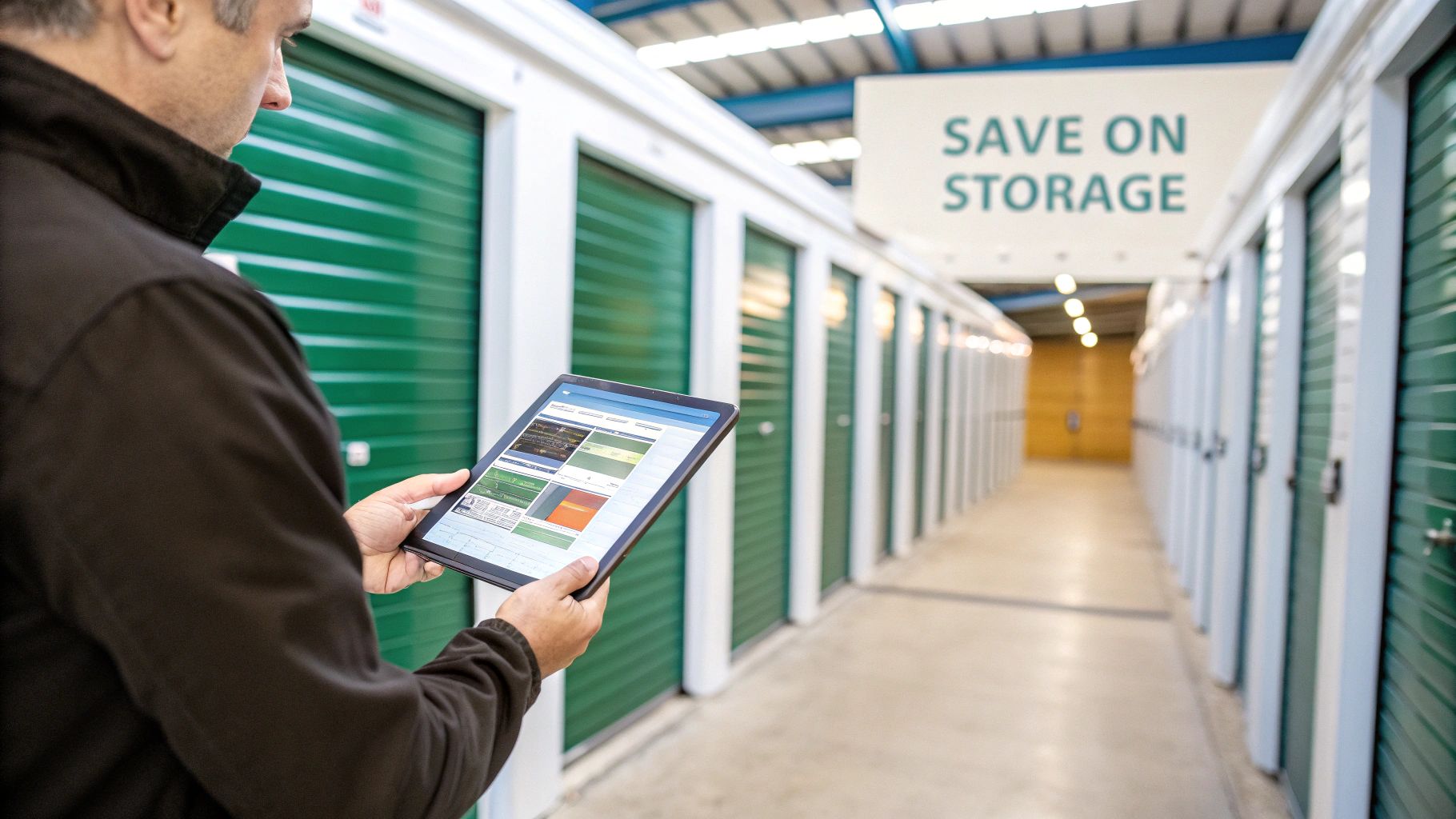
Before we jump into a side-by-side comparison, it’s really important to break down what actually goes into the price you’ll pay. That advertised rate is almost always a base figure, with other costs layered on top. Thinking about these things ahead of time will help you make a much smarter decision.
Unit Size and Facility Location
The two biggest things that will move the needle on your bill are the unit’s dimensions and where the facility is. It’s a lot like real estate—storage is going to cost you more in a packed city than it will out in the suburbs. A standard 10x10 unit in a major metro area can easily cost double what an identical unit costs just a few miles outside the city.
Size is the other half of that equation. You pay for the space you rent, whether you fill it to the brim or not. That’s why getting a realistic estimate of how much space you actually need is so critical. Otherwise, you’re just throwing money away on empty square footage.
Amenities and Special Features
Beyond the basics of size and location, certain features will bump up your monthly rate. Depending on what you’re storing, some of these might be non-negotiable.
- Climate Control: This is probably the most common (and valuable) add-on. A climate-controlled unit keeps the temperature and humidity stable, and it usually costs 15% to 30% more than a standard unit. If you're storing things like wood furniture, electronics, artwork, or important papers, it's essential for preventing damage from extreme heat or cold.
- Security Level: While most places have basics like cameras and a gate, some offer beefed-up security. Things like on-site guards, alarms on individual doors, and stricter access controls will add to the price tag.
- Access Type: Those convenient ground-floor or drive-up units? They often come at a premium. If you’re willing to use an elevator to get to an upper-level unit, you can sometimes find some modest savings.
A classic mistake we see all the time is someone renting a big, traditional unit when they really only need to store a handful of boxes. This is exactly where modern alternatives can save you a ton of money by tying your costs directly to what you’re actually using.
Promotions and Rental Agreements
Finally, don’t forget about special offers and the fine print in your rental agreement. Lots of facilities will lure you in with an amazing "first month free" or "50% off" deal. The catch? The rate often jumps way up after that intro period. It’s crucial to read the full terms. On the flip side, some providers give you a discount if you commit to a longer term or pay upfront.
For a completely different approach with no hidden surprises, you can see how we do things on our detailed pricing page.
Choosing Between Per-Box and Per-Square-Foot Pricing
When you’re looking at storage options, one of the first and most important decisions you'll face boils down to two very different pricing models: the classic per-square-foot unit or a modern per-box service. This isn't just a minor detail—it fundamentally shapes what you'll pay, how convenient storage is, and the way you access your things. Getting this choice right is the key to avoiding the common mistake of paying for space you simply don't need.
Traditional self-storage, the kind most people picture, runs on a per-square-foot model. You rent a room, usually something like a 5x5 or 10x10 unit, and you pay a set price every month whether you fill it to the brim or just use a corner. This is still the go-to for anyone storing big, bulky items like furniture, appliances, or the entire contents of an apartment during a move.
The Value of Direct Access
The biggest perk of a traditional unit is having direct, anytime access. If you’re a business owner who needs to grab inventory, a homeowner who frequently uses their lawnmower, or just someone who likes to sort through seasonal decorations, having your own key to your own space is unbeatable. You can show up, unlock the door, and manage your stuff on your own time.
But that convenience has a fixed price tag. You're paying for the potential of the entire space, not just what you're actually using. It's a surprisingly common scenario for people to end up paying for a half-empty unit month after month, essentially throwing money away on unused square footage.
This chart gives you a sense of how much prices can fluctuate for the same size unit based on features.
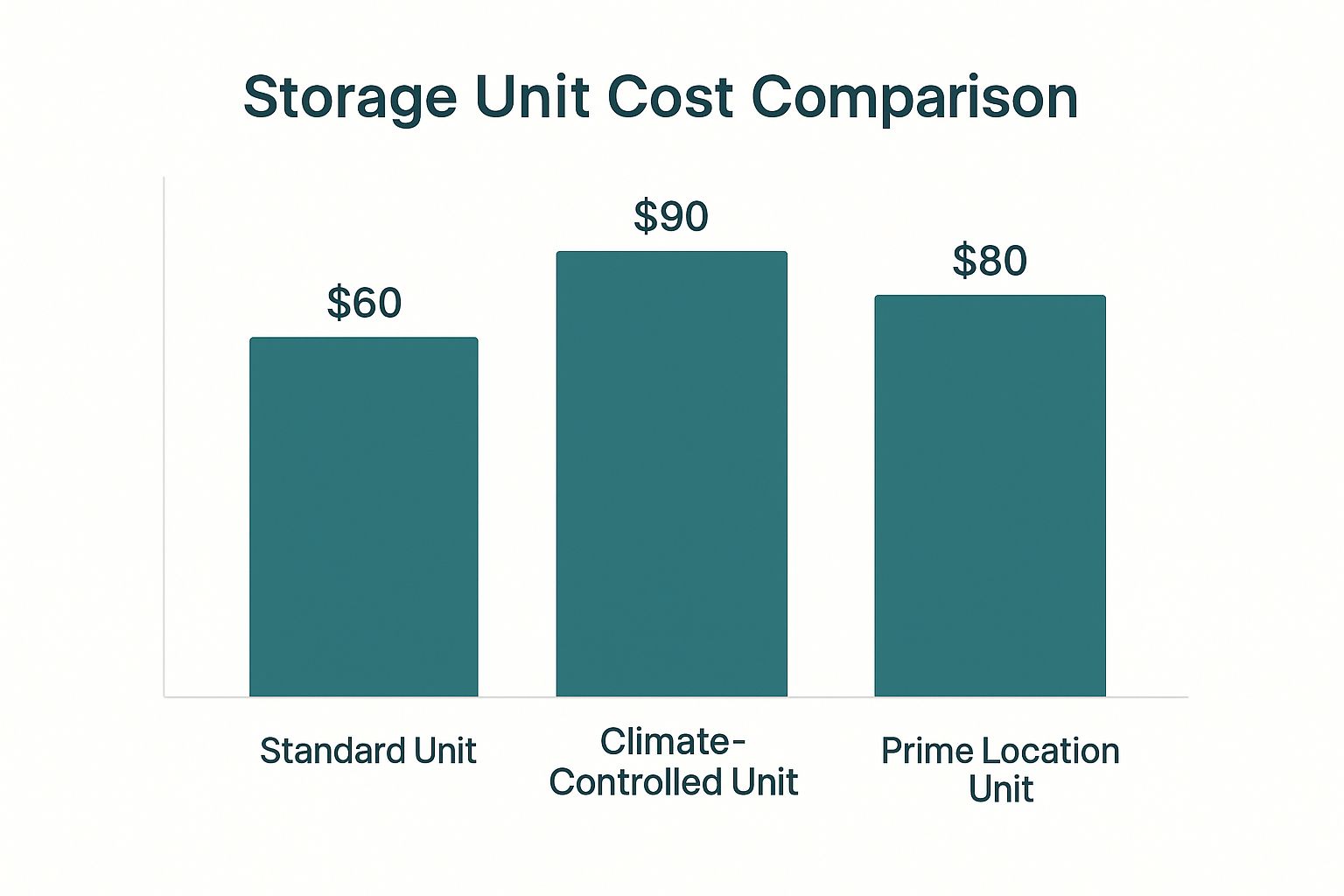
As you can see, things like climate control or being on the ground floor can really push that monthly bill up, even before you put a single item inside.
A Modern Alternative with Per-Box Pricing
On the other hand, valet storage services like Endless Storage flip the model on its head. With per-box pricing, you only pay for the specific boxes or items you're storing. It’s a perfect fit for decluttering your apartment, stashing away seasonal clothes, or archiving documents you don't need at your fingertips.
This approach completely takes the guesswork out of picking a unit size. It's an incredibly efficient way to handle storage costs, especially if you live in a city where space is already at a premium.
The philosophy behind per-box storage is refreshingly simple: stop paying for empty air. Your costs are tied directly to your actual storage needs, which often makes it a much smarter and cheaper solution for smaller collections of belongings.
It's also worth noting how much market trends affect traditional storage costs. In 2023, the average monthly rate for a storage unit in the U.S. dropped by 12.59% to $96.16—the biggest dip in over a decade. This was largely tied to a cooling housing market, meaning fewer people were moving and needing space. You can get more details on these 2023 storage rate trends on Storable.com.
Making the Right Choice for Your Needs
So, which model makes the most sense for you? It really comes down to two simple questions: what are you storing, and how often do you need to get to it?
To make it even clearer, here’s a breakdown of how the costs and benefits stack up in real-world situations.
Cost Comparison: Per-Box vs. Per-Square-Foot Models
This table shows some common storage scenarios to help you see which pricing model offers better value based on what you need to store.
The numbers show that for smaller, item-based storage, the per-box model is a clear winner on cost. But as soon as bulky furniture enters the picture or the number of boxes gets high, a small traditional unit can become more economical.
Here’s a final checklist to guide your decision:
Choose per-square-foot (traditional) if:
- You're storing large, awkward items like couches, mattresses, or major appliances.
- You need to get to your things often and on your own schedule.
- You’re putting the contents of an entire room or home into storage during a move.
Choose per-box (valet) if:
- You have smaller items to store, like books, clothes, files, or collectibles.
- You don’t need to access your items immediately or frequently.
- You want to skip the hassle of hauling everything to a storage facility yourself.
By taking a moment to think about your specific needs, you can confidently compare your options and pick the storage solution that’s both practical and budget-friendly.
Exposing Hidden Fees That Inflate Your Storage Bill
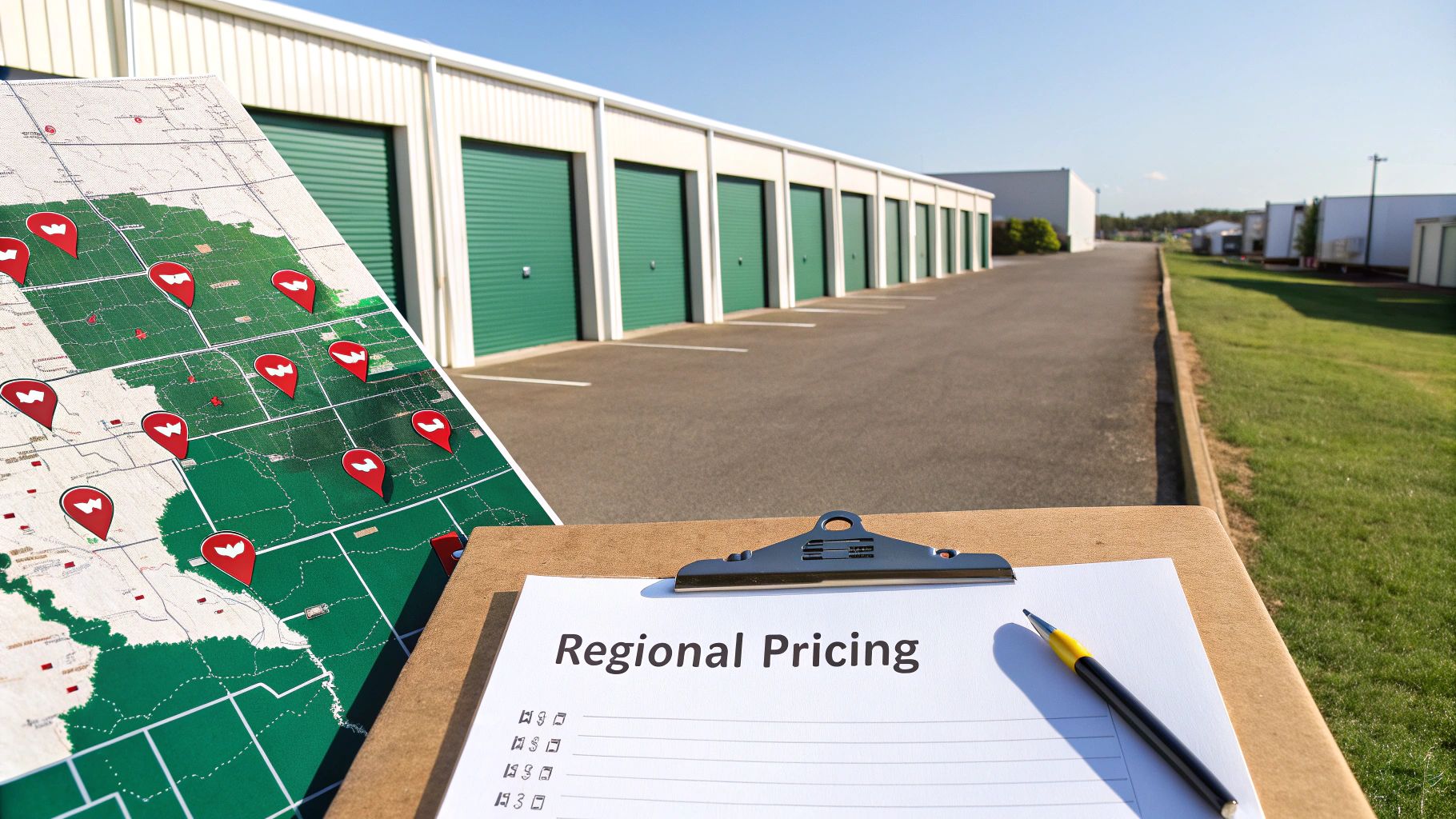
When you’re shopping around for a storage unit, that advertised price is rarely what you’ll actually end up paying. It's frustrating, but true. The low monthly rate is just the hook; the real cost comes from a laundry list of extra charges tacked on later.
Knowing what these common hidden fees are is the only way to figure out the true cost of storage and avoid that sinking feeling when your first invoice arrives. These charges are pretty standard at traditional facilities, but they can easily bloat your total expense if you aren't prepared.
Common Additional Storage Charges
First up is the one-time administrative fee, which usually runs between $20 to $35. This covers the "cost" of setting up your account and doing the paperwork. It might not sound like a lot, but it’s an immediate, non-refundable charge you have to pay upfront.
Then there's the security deposit, often equal to one month's rent. You'll probably get it back when you move out, but in the meantime, it ties up your cash and adds to your initial move-in cost.
Beyond those one-offs, a couple of recurring costs often catch people by surprise: mandatory insurance and lock requirements.
- Mandatory Insurance: Most self-storage places require you to insure your belongings because their own policy doesn’t cover your stuff. They’ll happily sell you their preferred plan, which can add $10 to $30 to your bill every single month. It's always worth checking if your homeowner's or renter's insurance already covers items in storage—it could save you a decent chunk of change.
- Specialized Locks: You can't just use any old padlock. Facilities often insist you buy their specific type, usually a high-security disc lock. These can cost anywhere from $15 to $50, another unexpected expense you have to pay before you can even start moving in.
Always demand a complete fee breakdown in writing before you sign anything. A transparent company will have no problem giving you a list of every potential charge, from setup fees to what happens if you pay late.
Penalties and Other Costs
Speaking of late payments, the penalties can be steep. Miss the due date by even a day, and some facilities will hit you with a significant percentage-based fee that quickly inflates your bill. For a deeper dive into what to expect from your monthly bill, check out our guide on how much storage costs monthly.
On top of all that, you might find charges for things like 24-hour access or even "convenience" fees just for paying your bill online. It all adds up.
This is where services like Endless Storage are different. We build everything into one simple, straightforward price. You'll never see surprise administrative fees, lock costs, or mandatory insurance upcharges. It's an honest approach designed to keep your budget predictable and your storage experience stress-free.
How Location Impacts Your Total Storage Cost
When you’re pricing out storage units, geography is one of the biggest factors driving the final cost. It works a lot like real estate—the price you pay for space is directly tied to what’s happening in the local market. A storage unit in a packed, popular city center can easily cost double, or even triple, the price of the exact same size unit just a few miles down the road in the suburbs.
This price gap all comes down to simple supply and demand, which is heavily influenced by how much commercial land costs in the area. Where land is a premium and lots of people need storage, facility owners have no choice but to pass those higher costs on to you. But in areas with more open space and fewer competitors, prices tend to be much friendlier.
This is exactly why you can’t trust a "national average" price to tell you the whole story. It might give you a vague idea, but it completely misses the massive price differences you’ll find from one zip code to the next.
The Urban vs. Suburban Price Divide
The difference isn't small, either. A facility right in a city's downtown core is always going to have a higher price tag because you’re paying for convenience. But if you don’t need to access your things every day, just expanding your search radius a little bit can lead to some serious savings.
Take this real-world scenario:
- A 5x10 unit in a major downtown area might run you $150 per month.
- That same 5x10 unit, from the same company, could be just $85 per month if it’s located 15 miles outside the city.
That’s $780 back in your pocket over the course of a year, all for being a little more flexible on location. For anyone planning on storing things for a while, this is a game-changing strategy. Our guide on long-term storage tips dives deeper into how to optimize your costs over time.
Don’t just look for the closest storage facility. A 20-minute drive could literally cut your monthly storage bill in half. Always compare prices in adjacent neighborhoods and suburbs before signing a contract.
Understanding Regional Price Fluctuations
It’s not just about city versus suburbs—prices can swing wildly from one region of the country to another. These differences are a reflection of bigger economic trends, population growth, and what’s happening in the local housing market.
For example, data from mid-2023 showed just how wide this gap can get. Markets out West had the highest average rent, hitting $170 per square foot, while other regions stayed pretty flat. This came after a post-pandemic surge that pushed the national average to an all-time high of $134 per square foot in late 2022. Even though things have cooled off a bit, rents are still about 30% higher than they were before the pandemic, which shows just how much market dynamics can affect your wallet. You can dig into more of these regional self-storage performance trends if you’re curious.
What all this data really shows is that a "good deal" is completely relative to where you live. The key is to shop smart. Use online tools to compare prices across a few different facilities and neighborhoods, not just the one right down the street. A little extra research goes a long way.
A Head-To-Head Comparison of Storage Models
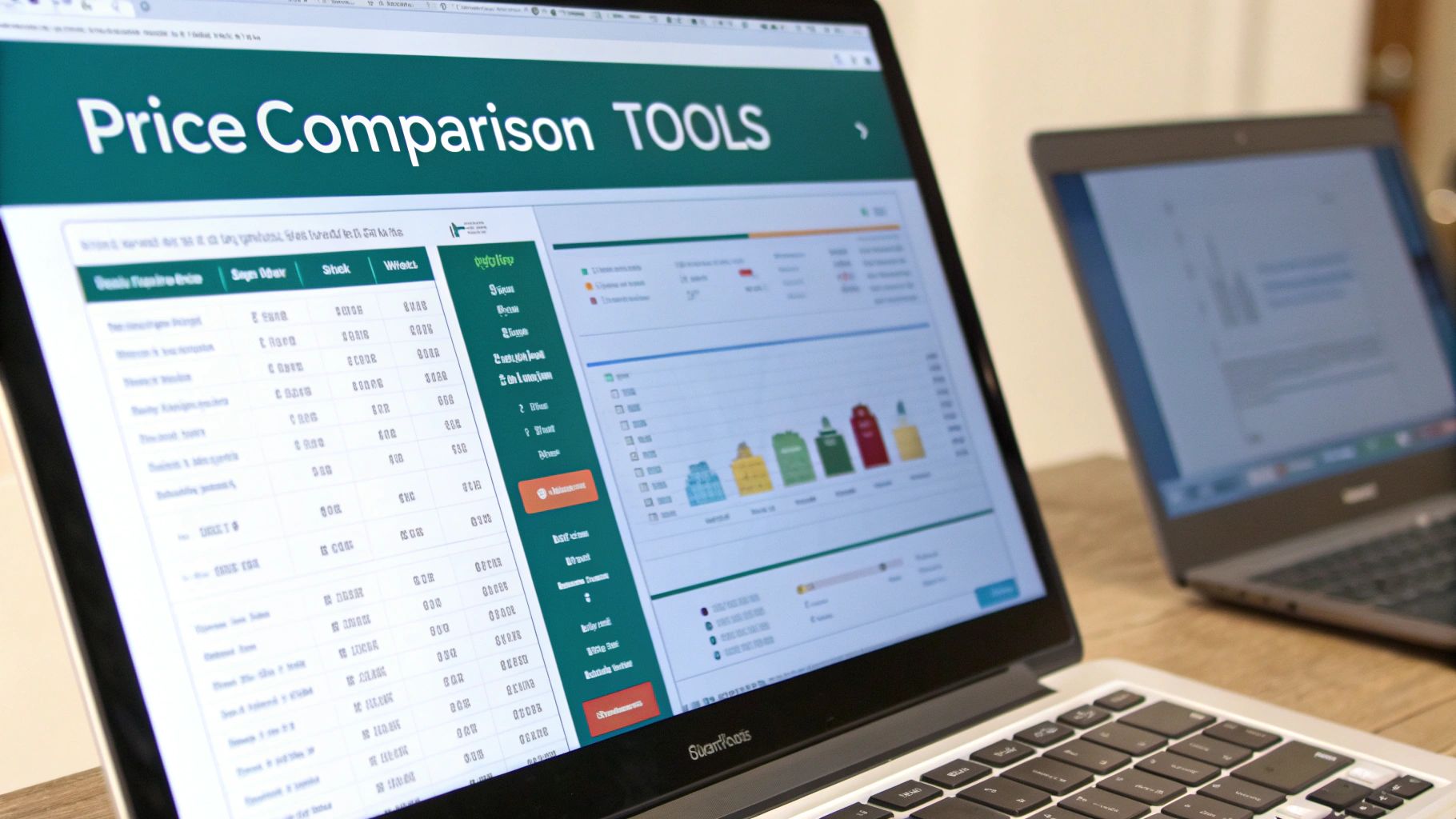 Now that we've untangled pricing models and those sneaky hidden fees, it's time to put it all together. When you start comparing storage unit prices, you’ll find it’s really a choice between two completely different experiences: the classic, do-it-yourself approach of traditional self-storage versus the effortless convenience of modern valet storage.
Now that we've untangled pricing models and those sneaky hidden fees, it's time to put it all together. When you start comparing storage unit prices, you’ll find it’s really a choice between two completely different experiences: the classic, do-it-yourself approach of traditional self-storage versus the effortless convenience of modern valet storage.
There’s no single “right” answer here. The best choice depends entirely on what you need. Are you trying to find a place for bulky furniture, or are you just stashing a few boxes? Do you need to pop in and grab things whenever you want, or are you storing items for the long haul? Figuring this out is the real key to finding the most cost-effective solution for you.
Cost and Convenience: The Core Differences
Traditional self-storage gives you a physical space that you control. You rent a room—maybe a 5x5 or 10x10 unit—and it's on you to get your stuff there, pack it in, and retrieve it later. This model is perfect for someone who needs frequent, unscheduled access, like a small business owner managing inventory.
On the flip side, valet services like Endless Storage are built around convenience and making sure you only pay for what you actually store. We send you the boxes, you pack them up, and we handle the pickup and storage in a secure, climate-controlled facility. This completely cuts out the hassle of renting a truck or losing a weekend to heavy lifting, which is a game-changer for city dwellers or anyone who wants to declutter without the back-breaking work. If you're exploring other ways to simplify storage, check out our guide on storage unit alternatives.
The core trade-off is simple: Traditional storage offers direct access for a fixed price on a block of space. Valet storage gives you door-to-door service where you only pay for the exact items you store, which often leads to major savings.
A Situational Breakdown
To really compare storage unit prices, let's look at how each model stacks up in a few common situations. It's also worth remembering that local market conditions can throw a wrench in traditional unit pricing. While the national average for a standard 10'x10' unit was around $123 in early 2024, some cities saw prices jump by over 50% due to high demand. You can learn more about these self-storage industry statistics on StorageCafe.com.
That kind of volatility makes a direct, situational comparison even more important.
Scenario 1: Storing Furniture for a MoveIf you're stashing the entire contents of an apartment—we're talking couches, beds, and dining tables—a traditional 10x15 unit is your best bet. The per-square-foot model is simply better suited for these large, awkwardly shaped items.
Scenario 2: Decluttering and Seasonal StorageFor things like seasonal clothes, holiday decorations, or sentimental keepsakes you don't need every day, valet storage is way more efficient. Paying $8-$15 per box makes a lot more sense than shelling out $60+ per month for a half-empty 5x5 unit.
This table breaks down which option is best depending on your needs.
Frequently Asked Questions About Storage Pricing
When you're comparing storage unit prices, the same few questions always seem to come up. Getting clear, honest answers is the final step before you can confidently pick the right storage solution. Let’s walk through the most common concerns so you feel fully prepared.
What Is the Most Common Mistake When Choosing a Storage Unit?
The single biggest mistake people make is getting fixated on the advertised monthly rent. They completely overlook the total cost, which gets quietly inflated by mandatory insurance, one-time "admin" fees, and the required purchase of a high-security lock.
These little extras can easily tack on $30 to $50 to your very first bill and another $10 to $30 to every single monthly payment after that. It adds up fast.
Another classic error is renting a unit that’s way too big. It's so easy to do, especially if it's your first time. You end up paying for empty, unused space month after month. To avoid this, always insist on a full quote that includes every single fee. And before you commit, use an online calculator to get a realistic estimate of your space needs. For an even more detailed breakdown, our complete storage unit size guide offers helpful room-by-room visuals.
Valet services like Endless Storage completely sidestep this problem. Since you only pay for the specific boxes or items you store, there’s zero risk of paying for empty air. Your bill always perfectly matches what you actually use.
Is Storage Unit Insurance Necessary?
Yes, in almost every case, storage insurance is mandatory. Your rental agreement will make it very clear that the facility isn't liable if your property is damaged or lost. They require you to have coverage—and they are more than happy to sell you their own policy.
But be careful. The insurance offered at the front desk is often just a basic, third-party policy. It might cover a major disaster like a fire or theft, but it could have glaring exclusions for more common problems like water damage from a leaky roof or a pest infestation.
Before you sign up for their plan, check your existing homeowner's or renter's insurance. Many policies already cover personal property stored off-site, and your current plan might offer far better coverage for less money.
How Can I Find the Best Deal on a Storage Unit?
Finding a genuinely good deal takes a bit of smart shopping and flexibility. Don't just settle for the facility right around the corner.
- Expand Your Search: Look at facilities a few miles outside your immediate area. Prices often drop significantly once you get into more suburban spots.
- Hunt for Promotions: Many places run online-only specials, like the first month free or 50% off for three months. Just be sure to read the fine print to see what the rate jumps to after the deal ends.
- Ask for a Price Match: Found a better price at a comparable facility nearby? Don't be shy. Call the other facility and ask if they can match it. You’d be surprised how often this works.
- Consider Alternative Models: If you don't need to access your things all the time, per-box valet storage is almost always a cheaper and more convenient alternative to even the smallest traditional unit.
Ultimately, the best strategy is to compare all your options—from different locations to different service models—to find a solution that fits both your belongings and your budget.
Ready to stop paying for empty space and experience storage that comes to you? With Endless Storage, you get free packing supplies, convenient at-home pickup, and a simple, all-inclusive price per box. Get started with Endless Storage today!
Frequently Asked Questions
Unveiling the Secrets to Effortless Storage
Endless Storage is available nationwide. You pick a plan, tell us where to pickup, and we'll send a UPS van to collect, whichever state you're in.
Your shipping label will be sent to your email within a few minutes, if not instantaneously. It can also be accessed through your customer profile.
Your box will be shipped to one of our climate controlled self storage facilities in our closest self storage facility. Our manager will accept your package, notify you that your box has been received, and securely stored. Only our managers will have access to Endless Storage boxes.
Email us at admin@endless-storage.com click to live chat with us, or send us a message below.
Never! We're committed to transparent pricing with no surprises. You'll lock in your rate with no hidden fees and no long-term contracts.
Fast access guaranteed! Your boxes will arrive at your doorstep within 48 hours of requesting them back. Need to check on delivery? We provide tracking information for complete peace of mind.
Totally flexible! Store month-to-month with no long-term commitment and cancel anytime.
Everything's online! Use your account dashboard to:
• Set up automatic monthly payments
• Request box returns
• Update your address
• Order additional boxes
• Track shipments
Your boxes are insured up to $100 each. Our customer service team will help you file any necessary claims and resolve issues quickly.
Don't worry – we'll email you right away if there's a payment issue. Your items stay safe, though you may have temporary service interruption or late fees until payment is resolved.
When you request our free storage kits, you'll have 30 days to send in your boxes to activate your 3 months of free storage. Think of it like starting a gym membership – your activation window begins when you receive your kits, and your full free trial begins once you send in your first box. During your free months, you'll experience our complete storage service at no cost.
Your 30-day activation window begins when you receive your storage kits. We'll send you an email confirmation when your kits are delivered, marking the start of your activation period.
If you haven't sent any boxes for storage within your 30-day activation window, your free trial will expire and we'll begin charging the regular monthly rate of $9.99 per box. This helps ensure our storage kits go to customers who are ready to use our service.
A box costs $9.99 per month to store (plus sales tax). This price includes free shipping for standard boxes under 50 lbs. and smaller than 16"x16"x16"
Log into your Endless Storage account, locate the box you would like returned, and simply click Return My Box.
Yes, each box stored with us is insured for up to $100 throughout transit as well as the duration of storage within our facilities.
Your box will be at your doorstep within 48 hours of you requesting it back.
Store 10+ boxes? We'll pick them up for free! After your purchase, we'll contact you to schedule a convenient pickup time and arrange UPS collection.
We trust UPS with all shipments, and every box includes $100 insurance coverage. You'll receive tracking information to monitor your items' journey.
Yes! Visit any of our locations by appointment. Just bring a photo ID matching your customer profile.
For everyone's safety, we can't store hazardous materials, firearms, or perishables. All items must fit within our standard boxes.
It's easy! Order your storage kit online, and we'll ship it to you within 1-2 business days. Your shipping labels will be emailed instantly and available in your account.
We're here to help! Email us at admin@endless-storage.com, use our live chat, or send us a message through your account.
To cancel your storage service with Endless Storage, please email your cancellation request to admin@endless-storage.com. Our team will process your request within 2 business days and confirm your cancellation via email.
We understand packing takes time. However, to maintain your free trial benefits, you'll need to send at least one box within the 30-day activation window. If you need more time, you can always start with one box to activate your trial and send the rest later. You can always reach out to admin@endless-storage.com if you have any issues or concerns.
When you request our free storage kits, you're starting a 30-day window to begin using our storage service.
To avoid any charges, simply send at least one box for storage within 30 days to activate your 3-month free trial. If you decide not to use our service and don't send any boxes within the 30-day window, a one-time $50 fee will apply to cover the costs of materials and shipping. This helps ensure our storage kits go to customers who are ready to use our service.
Think of it like reserving a hotel room – we're setting aside space and sending specialized packing materials for your use. The fee only applies if you request materials but don't begin storage, similar to a hotel's no-show charge.
